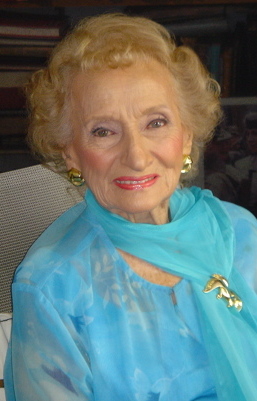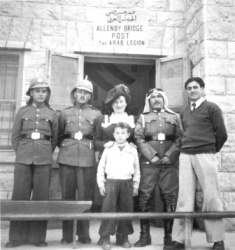Ruth Gruber facts for kids
Quick facts for kids
Ruth Gruber
|
|
|---|---|

Gruber in 2007
|
|
| Born | September 30, 1911 New York City, New York, U.S. |
| Died | November 17, 2016 (aged 105) Manhattan, New York, U.S. |
| Occupation | Journalist, photographer, writer, humanitarian, U.S. government official |
Ruth Gruber (born September 30, 1911 – died November 17, 2016) was an amazing American journalist, photographer, and writer. She also worked for the U.S. government and helped many people.
Born in Brooklyn to Russian Jewish immigrant parents, she was always encouraged to follow her dream of writing. At just 20 years old, she earned a special degree called a doctorate from the University of Cologne in Germany. Her paper was about the famous writer Virginia Woolf.
In the 1930s, Ruth became a well-known journalist. She wrote about women living under difficult political systems like fascism and communism. She even traveled to the Soviet Arctic! Later, she worked for two years in Alaska for the U.S. Department of the Interior.
During World War II, she focused on helping Jewish refugees. She worked for the Roosevelt administration and helped 1,000 refugees travel safely from Italy to the United States. She wrote down their stories. Ruth also saw what happened at the Port of Haifa when Holocaust survivors on the ship Exodus 1947 were not allowed into British-controlled Palestine. She wrote about their journey back to Germany. In later years, she covered the rescue of Ethiopian Jews to Israel. She won many awards for her work, including the Norman Mailer Prize.
Contents
Ruth Gruber's Early Life
Ruth Gruber was born in Brooklyn, New York. She was one of five children. Her parents, Gussie and David Gruber, were Russian Jewish immigrants. Ruth dreamed of becoming a writer. Her parents strongly supported her in getting a good education.
She started at New York University when she was only 15. At 18, she won a special scholarship to the University of Wisconsin–Madison. In 1931, she received another scholarship. This one allowed her to study in Cologne, Germany. She earned her Ph.D. from the University of Cologne. She studied German Philosophy, Modern English Literature, and Art History. At that time, she was the youngest person in the world to get a doctorate. Her main paper was about the writer Virginia Woolf.
While in Germany, Ruth saw Nazi rallies. After finishing her studies and returning to America, she warned people about the dangers of Nazism. Ruth's writing career began in 1932. In 1935, the New York Herald Tribune newspaper asked her to write a series of articles. These articles were about women living under Fascism and Communism. While working for the Herald Tribune, she became the first foreign reporter to fly through Siberia into the Soviet Arctic.
Helping During World War II
During World War II, Secretary of the Interior Harold L. Ickes chose Ruth Gruber as his special helper. Her job was to study Alaska and see if it would be a good place for soldiers to live after the war.
In 1944, she was given a secret mission. She had to go to Europe to bring 1,000 Jewish refugees and injured American soldiers from Italy to the U.S. To protect her, Ickes made her a "simulated general." This meant if her plane was shot down and she was captured by the Nazis, she would be kept alive under the Geneva Convention rules.
During the journey, the Army ship Henry Gibbins was hunted by Nazi planes and submarines. Ruth interviewed the refugees and wrote down their stories. Her book, Haven: The Dramatic Story of 1000 World War II Refugees and How They Came to America, was based on these interviews.
The U.S. Congress did not want to increase the number of Jewish immigrants allowed into the U.S. So, President Roosevelt used his power to invite the 1,000 refugees to visit America. When they arrived in New York, they were taken to Fort Ontario Emergency Refugee Shelter. This was an old Army base in Oswego, New York. They were kept behind a fence with barbed wire.
U.S. government groups argued about whether the refugees should stay or be sent back to Europe. Ruth Gruber worked hard to keep them in America until the war ended. In January 1946, they were finally allowed to apply to live in America. This was the only time the United States tried to shelter Jewish refugees during the war.
After the War: A Journalist's Journey

In 1946, Ruth Gruber took a break from her government job to go back to journalism. The New York Post asked her to report on a new group called the Anglo-American Committee of Inquiry on Palestine. This committee had to decide what would happen to 100,000 European Jewish refugees. These refugees were living in camps in Europe after the war.
Harry Truman, the U.S. President, urged Great Britain to let these 100,000 Jewish immigrants into British Mandate of Palestine. The committee members spent four months traveling in Europe, Palestine, and Arab countries. Then they spent another month in Switzerland. All twelve members agreed that Britain should allow the 100,000 Jewish immigrants into Palestine. However, the British foreign minister, Ernest Bevin, said no.
Later, the new United Nations took up the issue. They created a Special Committee on Palestine (UNSCOP). Ruth Gruber went with UNSCOP as a reporter for the New York Herald.
The Exodus 1947 Ship
Ruth Gruber saw the ship Exodus 1947 arrive at the Haifa harbor. The British Royal Navy had stopped it. The ship was trying to bring 4,500 Jewish refugees to Palestine. To meet the refugees, Ruth flew to Cyprus. There, she saw and photographed the refugees held by the British. The British then sent the refugees to Port-de-Bouc in France, and Ruth went there too.
The refugees refused to leave the ship. After 18 days, the British decided to send the Jews back to Germany. Many journalists from around the world were reporting on this. But Ruth Gruber was the only one the British allowed to go with the refugees back to Germany. On the prison ship Runnymede Park, Ruth photographed the refugees. They were held in a wire cage with barbed wire. They bravely raised a Union Jack flag on which they had painted a swastika.
Ruth Gruber's Later Life and Work
In 1951, Ruth married Philip H. Michaels. He was a community leader in the South Bronx. She had two children, including David Michaels, who later worked for the government. Ruth continued her travels as a journalist. She wrote a popular column for Hadassah Magazine called "Diary of an American Housewife." Her niece is the science writer Dava Sobel.
After Philip Michaels passed away in 1968, Ruth married Henry J. Rosner in 1974. He was a social services administrator in New York City.
In 1978, she spent a year in Israel. She wrote Raquela: A Woman of Israel. This book was about an Israeli nurse named Raquela Prywes. Raquela worked in a British detention camp and a hospital in Beersheba. This book won the National Jewish Book Award in 1979 for Best Book on Israel.
In 1985, when she was 74, Ruth visited isolated Jewish villages in Ethiopia. She wrote about the rescue of the Ethiopian Jews in her book Rescue: The Exodus of the Ethiopian Jews. Ruth Gruber received many awards for her writing and her humanitarian work. These included the Na'amat Golda Meir Human Rights Award and awards from the Simon Wiesenthal Center's Museum of Tolerance.
On October 21, 2008, Ruth Gruber was honored for her work defending free expression by the National Coalition Against Censorship. In 2016, an exhibit of her photographs called Ruth Gruber: Photojournalist was shown at the Oregon Jewish Museum in Portland.
Ruth Gruber passed away at the age of 105 on November 17, 2016.
In 2011, when Ruth Gruber was 100 years old, her work as a photojournalist was featured in a special exhibit. It covered six decades of her photos from four continents. The exhibit was at the International Center of Photography in New York. The exhibition, Ruth Gruber: Photojournalist, was put together by Maya Benton. It is traveling internationally until 2020. Ruth's photographs were shown in order by date. They included photos from the Soviet Arctic (1935-1936), Alaska Territory (1941–43), Henry Gibbons/Oswego, New York (1944), Exodus 1947, Runnymede Park (1947), Cyprus Internment Camp (1947), Israel/Middle East (1949–51), North Africa (1951-51), and Ethiopia (1985).
Ruth Gruber's first autobiography, Ahead of Time: My Early Years as a Foreign Correspondent, was published in 1991.
Movies About Ruth Gruber
The 2001 television movie Haven is based on Ruth Gruber's life story. The film stars Natasha Richardson as Ruth Gruber. Anne Bancroft played her mother, Gussie. Anne Bancroft was nominated for an Emmy Award for her role. A documentary about Ruth Gruber's life, called Ahead of Time, was released in 2010.

